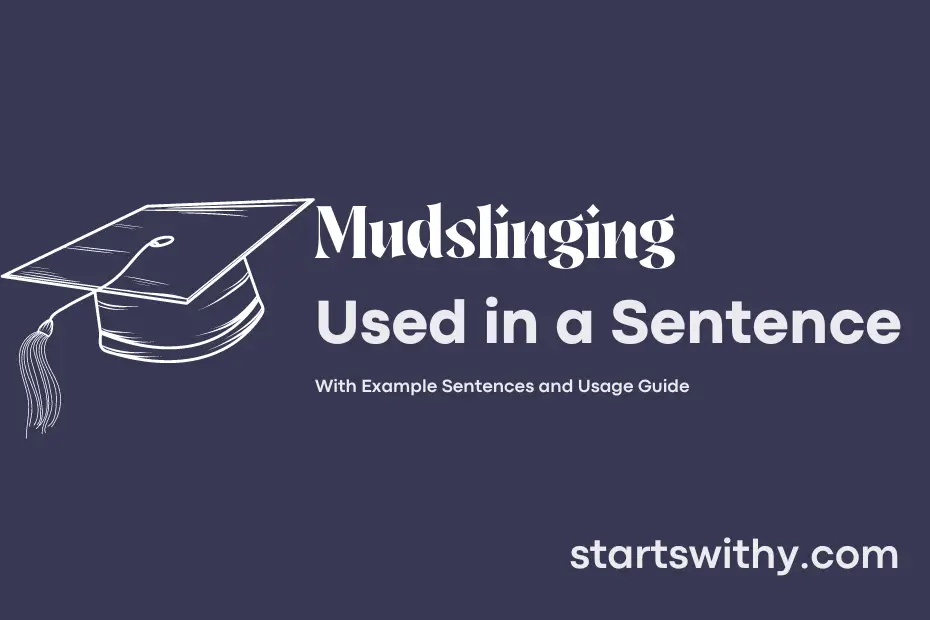What exactly is “mudslinging”? Mudslinging refers to the act of making malicious and damaging remarks about someone in order to harm their reputation. This often involves the spread of rumors or insults in an attempt to discredit or undermine the target.
In many cases, mudslinging occurs in the context of political campaigns, where candidates may resort to negative tactics to gain an advantage over their opponents. However, this behavior is not limited to politics and can be seen in various other settings where individuals or groups engage in personal attacks or smear campaigns.
7 Examples Of Mudslinging Used In a Sentence For Kids
- Mudslinging is when we say mean things to someone.
- It’s important to be kind and not do mudslinging.
- Let’s use words that are nice instead of mudslinging.
- We can make friends by not doing mudslinging.
- Mudslinging can hurt someone’s feelings.
- We should always remember to be polite and avoid mudslinging.
- We can show love by not participating in mudslinging.
14 Sentences with Mudslinging Examples
- Mudslinging during student council elections can lead to a divisive campus environment.
- Engaging in mudslinging on social media reflects poorly on a student’s maturity and professionalism.
- Participating in mudslinging instead of focusing on academics can be detrimental to a student’s grades.
- Students should avoid resorting to mudslinging when faced with disagreements or conflicts.
- Mudslinging in group projects can hinder the team’s progress and lead to a breakdown in communication.
- Seeking help from a counselor can be beneficial if students are experiencing the effects of mudslinging.
- Engaging in mudslinging may damage a student’s reputation and relationships with peers.
- Professors may address mudslinging behavior during lectures to emphasize the importance of respectful communication.
- Encouraging a culture of support and positivity can help deter mudslinging among college students.
- Students should be wary of engaging in mudslinging as it can escalate tensions and create a hostile campus environment.
- Peer mediation programs can help resolve conflicts between students before they resort to mudslinging.
- Student leaders have a responsibility to address instances of mudslinging and promote a culture of mutual respect.
- Learning effective communication skills can prevent misunderstandings that often lead to mudslinging.
- Engaging in mudslinging can distract students from their goals and hinder their personal development.
How To Use Mudslinging in Sentences?
Mudslinging is the act of making malicious and damaging statements, often in a public manner, to discredit someone or tarnish their reputation. In order to use “mudslinging” in a sentence effectively, follow these steps:
-
Choose a Target: Select a person or group that you want to target with negative or false statements. This could be a political rival, a competitor in business, or even a personal enemy.
-
Craft Your Message: Come up with false or damaging information about your target. This information could be exaggerated, twisted, or completely fabricated to make them look bad.
-
Make it Public: Share your damaging message with others, whether it’s through social media, the press, or in a public speech. The goal is to reach as many people as possible to damage your target’s reputation.
-
Be Prepared for Backlash: Keep in mind that mudslinging can have consequences, such as legal action or damage to your own reputation. Be prepared for potential backlash from your target or the public.
-
Use in a Sentence: “The politician resorted to mudslinging tactics during the debate, spreading false rumors about his opponent to gain an advantage.”
Remember to use mudslinging responsibly and consider the impact it may have on both the target and yourself.
Conclusion
In conclusion, mudslinging in politics is a common practice where candidates attack each other through negative and often false or misleading statements. These sentences with mudslinging aim to tarnish the opponent’s image or credibility in the eyes of voters. This form of campaigning can sway public opinion, but it can also lead to a toxic political atmosphere that focuses more on tearing down opponents rather than discussing important issues.
While mudslinging may be effective in the short term, it can erode trust in the political process and breed cynicism among voters. It is essential for politicians and the public alike to be discerning of such tactics and prioritize constructive dialogue and substantive debates over personal attacks. Ultimately, a political environment free from excessive mudslinging is crucial for fostering a healthy democracy where issues and ideas take precedence over character assassination.



